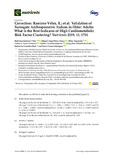Mostrar el registro sencillo del ítem
Validation of surrogate anthropometric indices in older adults: what is the best indicator of high cardiometabolic risk factor clustering?
| dc.creator | Ramírez Vélez, Robinson | es_ES |
| dc.creator | Pérez Sousa, Miguel A. | es_ES |
| dc.creator | Izquierdo Redín, Mikel | es_ES |
| dc.creator | Cano Gutiérrez, Carlos Alberto | es_ES |
| dc.creator | González Jiménez, Emilio | es_ES |
| dc.creator | Schmidt Río-Valle, Jacqueline | es_ES |
| dc.creator | González Ruiz, Katherine | es_ES |
| dc.creator | Correa Rodríguez, María | es_ES |
| dc.date.accessioned | 2020-02-18T13:10:06Z | |
| dc.date.available | 2020-02-18T13:10:06Z | |
| dc.date.issued | 2019 | |
| dc.identifier.issn | 2072-6643 | |
| dc.identifier.uri | https://hdl.handle.net/2454/36279 | |
| dc.description | Incluye correcciones | es_ES |
| dc.description.abstract | The present study evaluated the ability of five obesity-related parameters, including a body shape index (ABSI), conicity index (CI), body roundness index (BRI), body mass index (BMI), and waist-to-height ratio (WtHR) for predicting increased cardiometabolic risk in a population of elderly Colombians. A cross-sectional study was conducted on 1502 participants (60.3% women, mean age 70 ± 7.6 years) and subjects’ weight, height, waist circumference, serum lipid indices, blood pressure, and fasting plasma glucose were measured. A cardiometabolic risk index (CMRI) was calculated using the participants’ systolic and diastolic blood pressure, triglycerides, high-density lipoprotein and fasting glucose levels, and waist circumference. Following the International Diabetes Federation definition, metabolic syndrome was defined as having three or more metabolic abnormalities. All surrogate anthropometric indices correlated significantly with CMRI (p < 0.01). Receiver operating characteristic curve analysis of how well the anthropometric indices identified high cardiometabolic risk showed that WtHR and BRI were the most accurate indices. The best WtHR and BRI cut-off points in men were 0.56 (area under curve, AUC 0.77) and 4.71 (AUC 0.77), respectively. For women, the WtHR and BRI cut-off points were 0.63 (AUC 0.77) and 6.20 (AUC 0.77), respectively. In conclusion, BRI and WtHR have a moderate discriminating power for detecting high cardiometabolic risk in older Colombian adults, supporting the idea that both anthropometric indices are useful screening tools for use in the elderly. | en |
| dc.format.extent | 16 p. | |
| dc.format.mimetype | application/pdf | en |
| dc.language.iso | eng | en |
| dc.publisher | MDPI | en |
| dc.relation.ispartof | Nutrients, 2019, 11 (8), 1701 | en |
| dc.rights | © 2019 by the authors. Licensee MDPI, Basel, Switzerland. This article is an open access article distributed under the terms and conditions of the Creative Commons Attribution (CC BY) license. | en |
| dc.rights.uri | http://creativecommons.org/licenses/by/4.0/ | |
| dc.subject | Anthropometric indices | en |
| dc.subject | Diagnosis criteria | en |
| dc.subject | Metabolic syndrome | en |
| dc.subject | Cardiometabolic risk | en |
| dc.subject | Elderly | en |
| dc.title | Validation of surrogate anthropometric indices in older adults: what is the best indicator of high cardiometabolic risk factor clustering? | en |
| dc.type | info:eu-repo/semantics/article | en |
| dc.type | Artículo / Artikulua | es |
| dc.contributor.department | Ciencias de la Salud | es_ES |
| dc.contributor.department | Osasun Zientziak | eu |
| dc.rights.accessRights | info:eu-repo/semantics/openAccess | en |
| dc.rights.accessRights | Acceso abierto / Sarbide irekia | es |
| dc.identifier.doi | 10.3390/nu11081701 | |
| dc.relation.publisherversion | https://doi.org/10.3390/nu11081701 | |
| dc.type.version | Versión publicada / Argitaratu den bertsioa | es |
| dc.type.version | info:eu-repo/semantics/publishedVersion | en |




